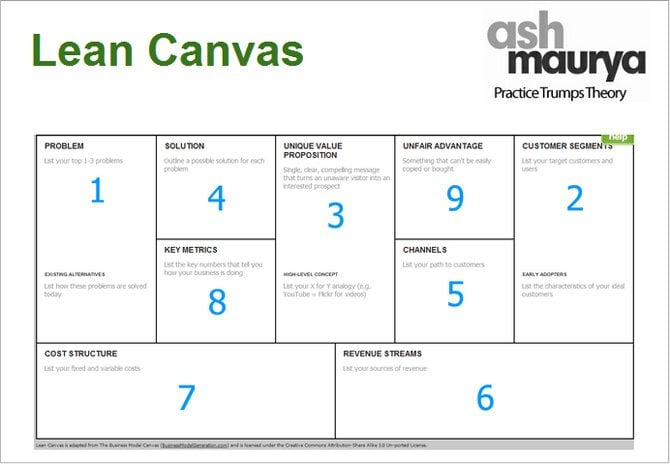A Startup on a Single Page? Fantastic?…Lean Canvas!
With what do you think every big deal starts? Endless pages and complicated calculations of a detailed business plan? A wise approach, but you never know if these investments of time and money will ever be recovered. What’s more, business plans, as a rule, can be difficult to understand and not all of your business partners may have the time or inclination to read one from cover to cover.
It definitely makes sense to start with something simple, something that can be drawn by hand on a sheet of paper or created on any gadget screen in a few minutes. We are talking about Lean Canvas now. With today’s hectic lifestyle, Lean Canvas is exactly what you need to put your own thoughts in order and provide a brief overview of the project to your team and other people with whom you are going to cooperate.
What is Lean Canvas? Get to know it from our brief lean canvas reviews
Lean Canvas was created by Ash Maurya in the Lean Startup spirit (a fast, concise and effective startup). It is an adaptation of Alexander Osterwalder’s Business Model Canvas with some sections replaced or removed. Lean Canvas is a helpful tool for the quick sketching of an actionable, entrepreneur-focused business plan. It is focused on problems, solutions, key metrics and competitive advantages. Lean Canvas has no specific medium of implementation and you can use it first and then shift to the Business Model Canvas or vice versa.
Who can use a Lean Canvas?
If you are a consultant, customer, advisor, or investor – Lean Canvas is not for you. It has been designed specifically for entrepreneurs, who wish to work with the aforementioned people.
One of the most beneficial features of Lean Canvas is that it fits on a single page, which means that it provides easy access, is fast, concise, and portable. If you are short of time – Lean Canvas is exactly what you need as you can avoid long negotiations and jump straight into filling in its fields and comments.
Please note that Lean Canvas is heavily focused on problem solving. It focuses on startup factors such as uncertainty and risk. Its methodology concentrates on understanding the problem. This is the first step and it’s really crucial. The product itself has little significance, as entrepreneurs are action oriented and need to build it first.
Lean Canvas boxes
Problem
In most of cases where there is a lack of proper problem understanding from the start, this can lead to failure of the whole project. A problem box was included in order to avoid investing a lot of time, effort and financial resources in building the wrong product. It is absolutely vital to understand the problem first.
Solution
Once the problem has been studied and stated, it’s time to find the best possible solution. A solution box with the Minimum Viable Product “MVP” concept was included for that purpose. It looks small on the canvas in order to constrain entrepreneurs and make them think well before filling in the box.
Key metrics
A startup can focus on one metric only. Just decide what it will be and ignore the rest. The metrics include the range of products or services you are going to provide. The wrong choice of metrics can be catastrophic! It will lead to wasteful activities like premature optimization or running out of resources while chasing the wrong goal. Keep in mind that initially the key metrics should center on your value metrics and later shift towards the key engines of growth.
Unfair advantage
Unfair advantage is actually another name for competitive advantage. A true unfair advantage is something that can’t be easily copied or bought. At first your startup might not have a true unfair advantage over other companies in the market. This field is aimed at encouraging you to work harder on finding (building) your unfair advantage and filling this blank box. The unfair advantage will serve as a kind of protection for your company against imitators in the future, once it becomes a success.
Why do we have Unique Value Proposition and Unfair Advantage?
Because they are often not the same thing. The job of a UVP is to capture a customer’s attention while the job of the Unfair Advantage is to deter copy cats and competitors.
Aren’t Problem and Unique Value Proposition the same thing?
The answer is ‘no’. The Problem box is intended to highlight the foreground problems customers face in their environments while the UVP is the marketing promise you make to them. It follows on from the intersection of the Problem and your Solution boxes.
Where do competitors go on the Lean Canvas?
Please note that your true competitors are not who you think they are, but who your customers think they are. That is why there is no use in listing well-known competitors. However, it makes sense in identifying how customers deal with their problems resorting to the existing alternatives.
There is an Existing Alternatives sub-section under the Problem box that is intended for this purpose.
Here are a few boxes removed from the original Lean canvas by Ash Maurya in order to improve it.
Key Activities and Key Resources
According to Ash’s opinion, Key Activities and Key Resources are more outside-focused when matched with the entrepreneur’s needs. They are covered in the Solution box.
Customer Relationships
A startup business should establish customer relationships from the very beginning. These are covered in the Channels box.
Key Partners
Ash omitted Key Partners category because most startups don’t require specific key partners at the beginning. They deal with unknown and untested products. So, it would be a waste of time trying to build such relationships.
Mediums for creating a Lean Canvas
Use the medium that is most natural to you. Some entrepreneurs prefer online tools because they help to reduce collaboration friction with other parties involved, especially when they are a long distance away from you and extremely busy. You can also use a notepad or a jumbo poster version if it’s more convenient for you.
Here are some tools that will help you create your Lean Canvas:
- Canvanizer
- Lean Launch Lab
- Canvas Model Lean Canvas
- Lean Canvas
Which version should you use? Should you start with Lean Canvas and then shift to Business Model Canvas?
It depends on what comes more naturally to you. The most important thing is that you document your key business model assumptions and learning in a portable format that you can share and discuss with other people.
Many entrepreneurs have used Lean Canvas successfully from idea creation to Product/Market Fit and beyond. The risks captured on Lean Canvas aren’t just early stage risks. They transform and evolve throughout the startup lifecycle.
Let’s go more visual and view the comparative table of Business Model Canvas and Lean Canvas.
As you already know, Business Model Canvas was proposed by Alexander Osterwalder. It was based on his earlier book: “Business Model Ontology”. Business Model Canvas outlines several prescriptions forming the building blocks for the activities. It lets new and running businesses focus on operational as well as strategic management and marketing plans. As to the Lean Canvas, it has been proposed by Ash Maurya as a development of the Business Model Generation. It is more problem focused and targeted on entrepreneurs and startup businesses.
So, as both models give analytical approaches vital for your business success, they create their own reasons for criticism. For instance, the Business Model Canvas is blamed for not taking into account the performance measurement and the business model management which are essential for the continued success of any business. In its turn, the Lean Canvas does not give the expected approach when the solution of the initial problem becomes unrealistic or extremely difficult to realize.
We advise you to watch this short video about principles of lean startup canvas, its boxes and their purposes to make sure that you understood everything correctly and can apply this brilliant tool to your startup.
Don’t miss out these all-time favourites
- The best hosting for a WordPress website. Tap our link to get the best price on the market with 82% off. If HostPapa didn’t impress you check out other alternatives.
- Website Installation service - to get your template up and running within just 6 hours without hassle. No minute is wasted and the work is going.
- ONE Membership - to download unlimited number of WordPress themes, plugins, ppt and other products within one license. Since bigger is always better.
- Ready-to-Use Website service is the ultimate solution that includes full template installation & configuration, content integration, implementation of must-have plugins, security features and Extended on-page SEO optimization. A team of developers will do all the work for you.
- Must-Have WordPress Plugins - to get the most essential plugins for your website in one bundle. All plugins will be installed, activated and checked for proper functioning.
- Finest Stock Images for Websites - to create amazing visuals. You’ll get access to Depositphotos.com to choose 15 images with unlimited topic and size selection.
- SSL Certificate Creation service - to get the absolute trust of your website visitors. Comodo Certificate is the most reliable https protocol that ensures users data safety against cyber attacks.
- Website speed optimization service - to increase UX of your site and get a better Google PageSpeed score.
Get more to your email
Subscribe to our newsletter and access exclusive content and offers available only to MonsterPost subscribers.




Leave a Reply
You must be logged in to post a comment.